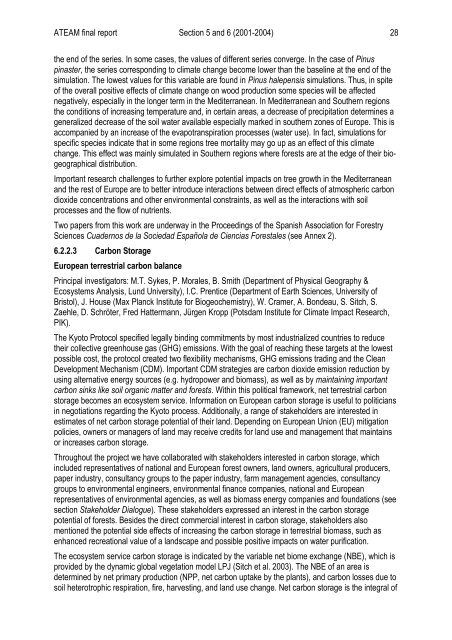ateam - Potsdam Institute for Climate Impact Research
ateam - Potsdam Institute for Climate Impact Research
ateam - Potsdam Institute for Climate Impact Research
You also want an ePaper? Increase the reach of your titles
YUMPU automatically turns print PDFs into web optimized ePapers that Google loves.
ATEAM final report Section 5 and 6 (2001-2004) 28<br />
the end of the series. In some cases, the values of different series converge. In the case of Pinus<br />
pinaster, the series corresponding to climate change become lower than the baseline at the end of the<br />
simulation. The lowest values <strong>for</strong> this variable are found in Pinus halepensis simulations. Thus, in spite<br />
of the overall positive effects of climate change on wood production some species will be affected<br />
negatively, especially in the longer term in the Mediterranean. In Mediterranean and Southern regions<br />
the conditions of increasing temperature and, in certain areas, a decrease of precipitation determines a<br />
generalized decrease of the soil water available especially marked in southern zones of Europe. This is<br />
accompanied by an increase of the evapotranspiration processes (water use). In fact, simulations <strong>for</strong><br />
specific species indicate that in some regions tree mortality may go up as an effect of this climate<br />
change. This effect was mainly simulated in Southern regions where <strong>for</strong>ests are at the edge of their biogeographical<br />
distribution.<br />
Important research challenges to further explore potential impacts on tree growth in the Mediterranean<br />
and the rest of Europe are to better introduce interactions between direct effects of atmospheric carbon<br />
dioxide concentrations and other environmental constraints, as well as the interactions with soil<br />
processes and the flow of nutrients.<br />
Two papers from this work are underway in the Proceedings of the Spanish Association <strong>for</strong> Forestry<br />
Sciences Cuadernos de la Sociedad Española de Ciencias Forestales (see Annex 2).<br />
6.2.2.3 Carbon Storage<br />
European terrestrial carbon balance<br />
Principal investigators: M.T. Sykes, P. Morales, B. Smith (Department of Physical Geography &<br />
Ecosystems Analysis, Lund University), I.C. Prentice (Department of Earth Sciences, University of<br />
Bristol), J. House (Max Planck <strong>Institute</strong> <strong>for</strong> Biogeochemistry), W. Cramer, A. Bondeau, S. Sitch, S.<br />
Zaehle, D. Schröter, Fred Hattermann, Jürgen Kropp (<strong>Potsdam</strong> <strong>Institute</strong> <strong>for</strong> <strong>Climate</strong> <strong>Impact</strong> <strong>Research</strong>,<br />
PIK).<br />
The Kyoto Protocol specified legally binding commitments by most industrialized countries to reduce<br />
their collective greenhouse gas (GHG) emissions. With the goal of reaching these targets at the lowest<br />
possible cost, the protocol created two flexibility mechanisms, GHG emissions trading and the Clean<br />
Development Mechanism (CDM). Important CDM strategies are carbon dioxide emission reduction by<br />
using alternative energy sources (e.g. hydropower and biomass), as well as by maintaining important<br />
carbon sinks like soil organic matter and <strong>for</strong>ests. Within this political framework, net terrestrial carbon<br />
storage becomes an ecosystem service. In<strong>for</strong>mation on European carbon storage is useful to politicians<br />
in negotiations regarding the Kyoto process. Additionally, a range of stakeholders are interested in<br />
estimates of net carbon storage potential of their land. Depending on European Union (EU) mitigation<br />
policies, owners or managers of land may receive credits <strong>for</strong> land use and management that maintains<br />
or increases carbon storage.<br />
Throughout the project we have collaborated with stakeholders interested in carbon storage, which<br />
included representatives of national and European <strong>for</strong>est owners, land owners, agricultural producers,<br />
paper industry, consultancy groups to the paper industry, farm management agencies, consultancy<br />
groups to environmental engineers, environmental finance companies, national and European<br />
representatives of environmental agencies, as well as biomass energy companies and foundations (see<br />
section Stakeholder Dialogue). These stakeholders expressed an interest in the carbon storage<br />
potential of <strong>for</strong>ests. Besides the direct commercial interest in carbon storage, stakeholders also<br />
mentioned the potential side effects of increasing the carbon storage in terrestrial biomass, such as<br />
enhanced recreational value of a landscape and possible positive impacts on water purification.<br />
The ecosystem service carbon storage is indicated by the variable net biome exchange (NBE), which is<br />
provided by the dynamic global vegetation model LPJ (Sitch et al. 2003). The NBE of an area is<br />
determined by net primary production (NPP, net carbon uptake by the plants), and carbon losses due to<br />
soil heterotrophic respiration, fire, harvesting, and land use change. Net carbon storage is the integral of
















